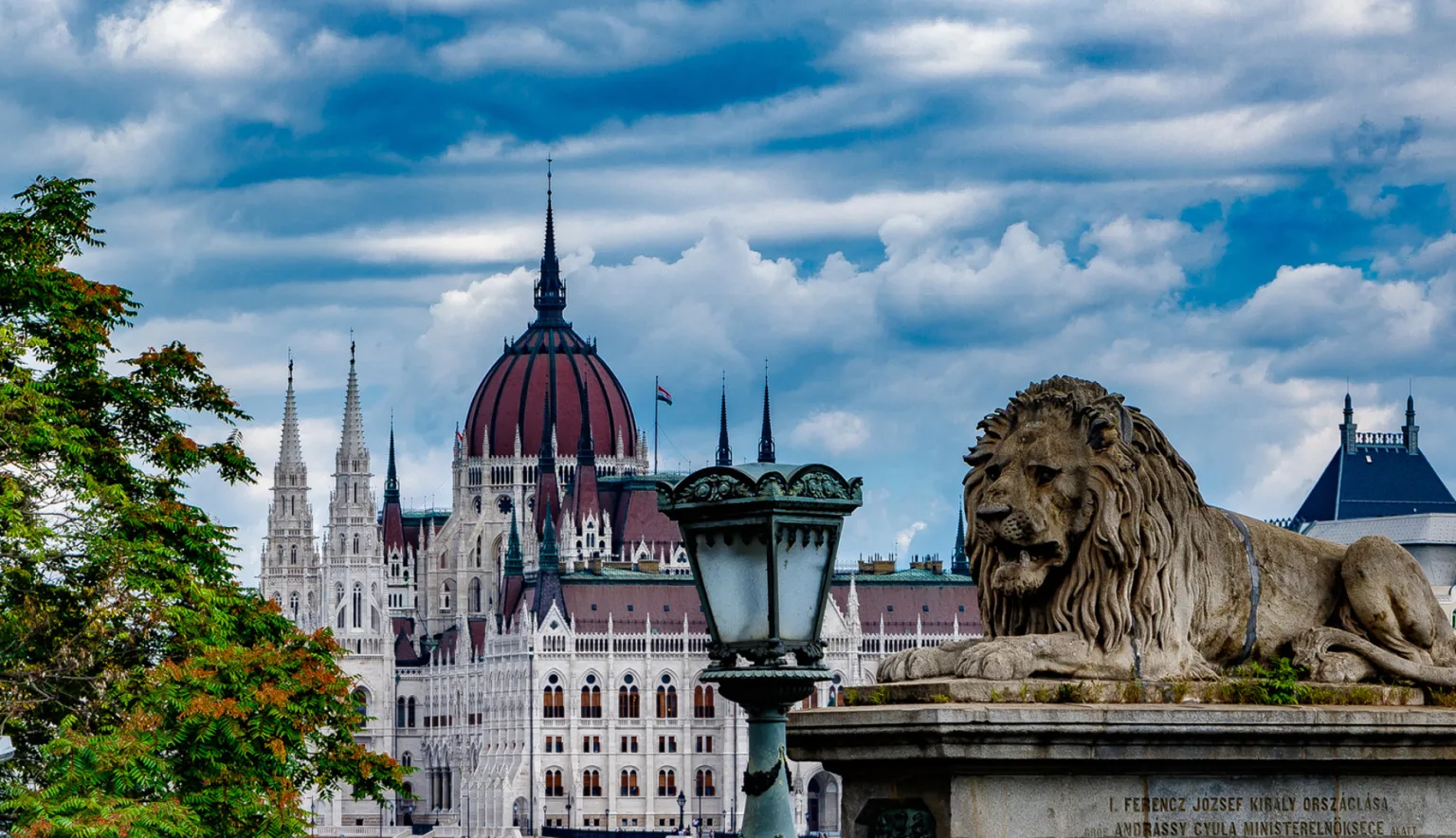From ruin bars to relaxing bathing spas, Budapest is a cauldron of culture, history and architectural beauty either side of the Danube.
BUDAPEST
Straddling the giant River Danube, Budapest has long served as Hungary’s cultural and administrative epicentre. Situated at the confluence of the country’s western hills and eastern and southern plains, the city is named after and split into two parts on either side of the river – Buda to the west and Pest to the east. While Budapest’s roots date back to Roman times, what visitors will see today is largely influenced by the 19th-century Austro-Hungarian empire, a period when Hungary was around three times the size it is today, the geopolitical aftermath of the First World War drastically reducing its landmass.
It is home to one in five Hungarians and the centre of transport and industry, with more than half the country’s university students attending institutions here. Budapest is an architectural marvel with many fascinating buildings offering immense views. The city, including the banks of the Danube, the Buda Castle Quarter, and Andrássy Avenue, was designated a UNESCO World Heritage site in 1987. A vast array of museums, monuments and public baths add into the cultural mix along with an unrivalled nightlife, no better experienced than by a visit to one of the famous ruin bars.
THE BUSINESS END
As well as being the cultural and administrative centre of Hungary, Budapest is also the country’s economic capital given all its major corporations, banks and transport hubs are here. Major income earners for the city are retail, food processing, building materials and education sectors, with tourism an increasingly important contributor to the local economy.
Predictions made by the World Travel & Tourism Council in mid-2018 estimated 17.5 million tourist arrivals for the whole of last year, a figure it expects to rise well above 20 million by 2028. The proportion of national GDP deriving from tourism is also increasing, with Hungary rising up the global ranks to 60th thanks to the industry’s seven percent contribution in 2017.
The country’s MICE industry is also on the rise. In 2017, the number of conferences organised in Hungary rose by 21.6 percent, Budapest alone accounting for 80 percent of all conference activity. In terms of international conferences, nearly 20 percent of these are organised by British clients, with Americans (18 percent), Germans (17.7 percent), French (7.2 percent), Dutch (5.8 percent) and Austrian (4.6 percent) organisers all paying frequent visits to the Hungarian capital.
TOURISM INSIGHTS: BUDAPEST FESTIVAL AND TOURISM CENTER
Budapest Festival and Tourism Center (BFTK) is the organisation which provides the official and strategic management of Budapest as a destination. BFTK came about as Budapest’s official organisation for tourism, culture and the marketing of both sectors.
“Our company’s aim from the beginning was to create a positive image on Budapest by positioning the capital of Hungary as a prominent cultural and tourist destination and by developing valuable cultural content,” explains its General Manager Teodóra Bán. “We have moved from an official role approach to a more modern role perception as a service provider, and now consider it important to provide experience-based services for visitors arriving to Budapest.”
Bán went on to answer our questions about all things Budapest tourism.
Q&A WITH TEODÓRA BÁN, GENERAL MANAGER, BFTK
Since inception, how has the Budapest Festival and Tourism Center developed and progressed in terms of its key objectives and the messages it tries to get across?
Teodóra Bán (TB): Since 2015 we have been working with the Budapest Tourism Round Table, reconciling the interests of various decision makers like the government, the city and the districts, as well as the managers of major projects and professional representatives of the tourist trade. The most pressing task is to find answers to the problems caused by overtourism and handle the huge number of visitors in certain parts of the city, promoting a more favourable spatial structure of tourism. BFTK also develops a coordinated tourist information system made up of the Budapestinfo Point network year after year. The office network business is constantly expanding as well, while online channels are also evolving. For example, last year we launched our B2B website along with our B2B newsletter. A further aim is to provide high-quality information to the foreign network of Hungary (including embassies, consulates and foreign trade services) and to supply them with professional support materials. To this end, we took serious steps in 2018. Meanwhile, the popularity of our Budapest Card is also getting stronger.
How would you say Budapest has developed in recent years as a business travel hub and what are the key reasons behind its growing appeal?
(TB): The most important keys to its success in being a great city for meetings and events include:
Easy access: Short flights from all European capitals: flight times less than two hours, multiple connections. Direct flights from Chicago, New York and Philadelphia to Budapest.
Well-developed infrastructure for conferences and incentives: Deluxe and five-star hotels, well skilled and knowledgeable guides, legendary art of cuisine, widely varied, extraordinary venues. Most of the famous sites and major hotels are in walking distance to each other. The public transportation is also very well developed, offering fast and nature friendly ways to get around the city.
Outstanding scenery: The River Danube flows through the heart of the city, lined with gorgeous buildings and other attractions on both banks. Budapest’s Danube bank scenery has been listed to UNESCO World Heritage Sites.
Good value for money: Studies regularly show Budapest as an affordable destination for business travellers. Last June, Budapest was ranked among world’s cheapest cities to relocate according to a study released by Nestpick.
Advanced shopping sites: You can find all major fashion brands right in the heart of the city centre. Andrássy Avenue is known as Budapest’s Cultural Avenue but also a hub of Budapest’s biggest fashion shops at the same time and Fashion Street is just a couple of minutes’ walk.
Why, in your opinion, should someone visit Budapest?
(TB): Scenery, gastronomy and culture are three major reasons. Budapest is a historical and modern city at the same time: the capital of Hungary is definitely the most party-coloured city of Central Europe – with a diverse cityscape and even the majestic Danube in the middle. Buda, with its romantic atmosphere and the stunning Royal Palace on one side, and Pest, a dynamic cultural hub on the other. You can go for a relaxing walk in the zigzagging streets of the Buda side anytime. Meanwhile, the Pest side offers a bustling, vibrant scene with an extraordinary Art Nouveau architecture and an inspiring atmosphere of the ‘Jewish Quarter. Budapest is a foodies’ hub. The capital of Hungary features a cuisine consisting of a blend of traditional Hungarian flavours and the latest dining trends – from street-food to haute cuisine creations featured in the Michelin Guide. 21st century Budapest is also one of the hubs of cultural life in Europe, offering the possibility of listening to contemporary and classical music, opera performed by internationally renowned stars, fiery local gypsy music, top class jazz, the ever popular operetta, folk music and dance in one of Budapest’s numerous concert halls, opera houses, restaurants, bars and music clubs. There are a variety of museums, art galleries and exhibition halls to explore. It is not so surprising that thousands of travellers from all over the world have voted for Budapest as the Best European Destination 2019. No other previously winning European travel destination has received such convincing international support: 77 percent of the votes in favour of Budapest came from outside Hungary.
What trends are transforming the tourism industry in Budapest at present? How are you responding to these trends?
(TB): The number of tourists coming to Budapest increased by nearly 75 percent in the past decade, while bed-nights at the commercial accomodations increased by 70 percent in the same period. This is due to affordable accommodation possibilities (like Airbnb), low-cost flights and the many tourist attractions as well as sophisticated programme offers. Besides traditional sights, there are more and more people who also look up special attractions, like a good restaurant, a unique building, or a peculiar programme. There is also an increase in some special branches of the tourism industry – for instance in shopping tourism and river cruising. A relatively new phenomenon is the increase in the number of Chinese guests on an astonishing scale; in the last seven years, the number of guests from China increased by more than four times, reaching almost 200,000 by the end of 2018. There are already severe signs of overtourism in Budapest, especially in the District VII – the so-called party district. The best antidote to overcrowding could be the temporal and spatial distribution of visitors – and the BFTK encourages the tendency by all means. To achieve this goal, the development of accommodation supply and programme offers to widen the scale of attractions is essential.
How do you see the city developing as a business travel hub over the next year to two years?
(TB): Statistics show that Budapest is one of Europe’s and the world’s favourite MICE tourism destinations. And, in domestic relations, the prime location of internationally organised MICE events is still Budapest – more than 80 percent of conferences in Hungary are held in the capital city.The main competitive advantages of Budapest in numbers are that we have the third fastest 4G mobile internet in the world and are the ninth safest destination to travel. Business travellers represent a very important segment for the BFTK because their spending is three to four times higher than that of leisure visitors. Based on statistical figures, ca. 654,000 MICE guests visited Budapest in 2018 Q1-Q3, a 6.2 percent growth compared with the same period of 2017. In order to serve this large number of guests, several conference centre plans are under construction, located within the Millennium Quarter of the city and the Hungexpo Budapest Fair Center. As a result of the realisation of these projects, the conference capacity index of Budapest will increase by at least 5,000 people.
Are there any plans or projects in the pipeline that you wish to highlight?
(TB): Asides the exciting sports developments, the pride of Budapest, Városliget (City Park) has been a scene of a major development in the past few years, so as to transform City Park into a cutting-edge museum quarter. The City Park is famous not only because of its 200-acre green area but also because of its wide range of institutions offering endless opportunities for entertainment, leisure and cultural activities. Its popular institutions, including the Museum of Fine Arts, the Museum of Hungarian Agriculture, the Budapest Zoo, the Kunsthalle, the Ice Rink and the Széchenyi Thermal Baths attract millions of visitors per year, but most of them must be renovated. Based on this heritage, the Liget Budapest Project ensures that this complexity will be preserved and improved by a higher quality environment and world-class services. The National Museum Restoration and Storage Center (OMRRK) and the reconstruction of the Olof Palme House will be completed in 2019. The complex’s reopening will be accompanied by a monumental exhibition presenting “The First Golden Age of Budapest and the City Park”. The construction of the House of Hungarian Innovations and the building of the New National Gallery designed by the Japanese Pritzker Prize-holder SANAA will begin at the same time. As a result, by 2020 City Park will be more liveable, more modern and much greener than it has been up to now, enriched with attractive institutions, making it worthy of its old fame.
Are you optimistic about the future of the tourism industry in Budapest?
(TB): Yes, definitely. Improving hotel revenue data resulted a remarkable construction boom on the Budapest hotel market. In 2017, 73 percent of the launched hotel projects in Hungary were located in the capital city. The total value of the ongoing construction works exceeded the pre-crisis maximum in 2015 and 2017 alike. In 2019, the iconic Párisi Udvar project, which is one of the largest hotel investments in recent years, can be completed – same as the four-star Emerald Residence. Besides, the construction of the Meininger Budapest Hotel, which was launched in 2015, is also going to be completed this year (room capacity: 184). And so on: the four-star Hilton Garden Inn Budapest Hotel with 214 rooms are already under construction, and the current largest project, the five-star Matild Palace – Luxury Collection are expected to be finished in 2019 Q2. The ascending sports capital image of Budapest complemented by the ongoing cultural and infrastructural developments – with particular regard to the Liget Project – predict a future of a great promise for the tourism industry.
OUT AND ABOUT IN BUDAPEST
Budapest has something for everyone, with the major must-do sights and experiences all within walking distance or a very short tram ride away. A river cruise at night is the best way to take in the stunning surrounds on the banks of Danube, with Castle Hill and the spectacular parliament building wonderfully lit up. These two sites are also well worth a visit in daylight hours, the former offering breath-taking views and home to a world-renowned annual wine festival in September. A trip to Budapest is also incomplete without experiencing once of the numerous public bathing houses, Szchenyi being the most popular and accessible with around 40 indoor and outdoor pools of varying temperatures.
The city is also renowned as a historic food capital of Europe, a reputation that is once more being enhanced and visitors discover there is much more to Hungarian food than goulash. The country’s wine is excellent, as showcased at the aforementioned festival, with sweet Tokaj making its mark and recognised for its quality around the world. Tourists may find themselves spending an evening in one of Budapest’s ruin bars, buildings consigned to dereliction that have been revitalised since the turn of the millennium. These of factories and houses now form a lively social hub of the city.
OUTLOOK RECOMMENDS
STAY:
EAT & DRINK:
DO:
BATHS:
GETTING THERE AND AROUND
Transport has been vital to Budapest’s rapid expansion, the city now serving as a hub for the country’s major trunk roads and rail routes and also home to the nation’s largest bus terminal. Ferenc Liszt International Airport lies around 25 kilometres southeast of the city centre and is not the most accessible by public transport. A bus route does run, but for ease and speed it is recommended to travel to and from the terminals by car/taxi.
In terms of getting around the city itself, more and more people can be sighted using bicycles and many are available for hire, while walking is another perfectly viable option for navigating the major attractions either side of the river. Budapest has four underground metro lines and more than 30 tram lines, which are often a pleasant way of seeing the city as several lines cross one of the major bridges or run along the riverbank. There is also an extensive bus network and around 15 trolleybus lines, and the best way to ride on these public transport options is by buying a travel pass. Otherwise you will have to make sure you validate a ticket every time you board.
“There are other cool ways for exploring the hidden gems of the capital,” adds Bán. “Budapest by night bike tour is also available to experience the charming atmosphere of the wonderful illuminated city, enjoying the breath-taking panorama of the Danube bank from Pest and Buda sides. Most of these special transport options are free for Budapest Card holders or heavily discounted.”























